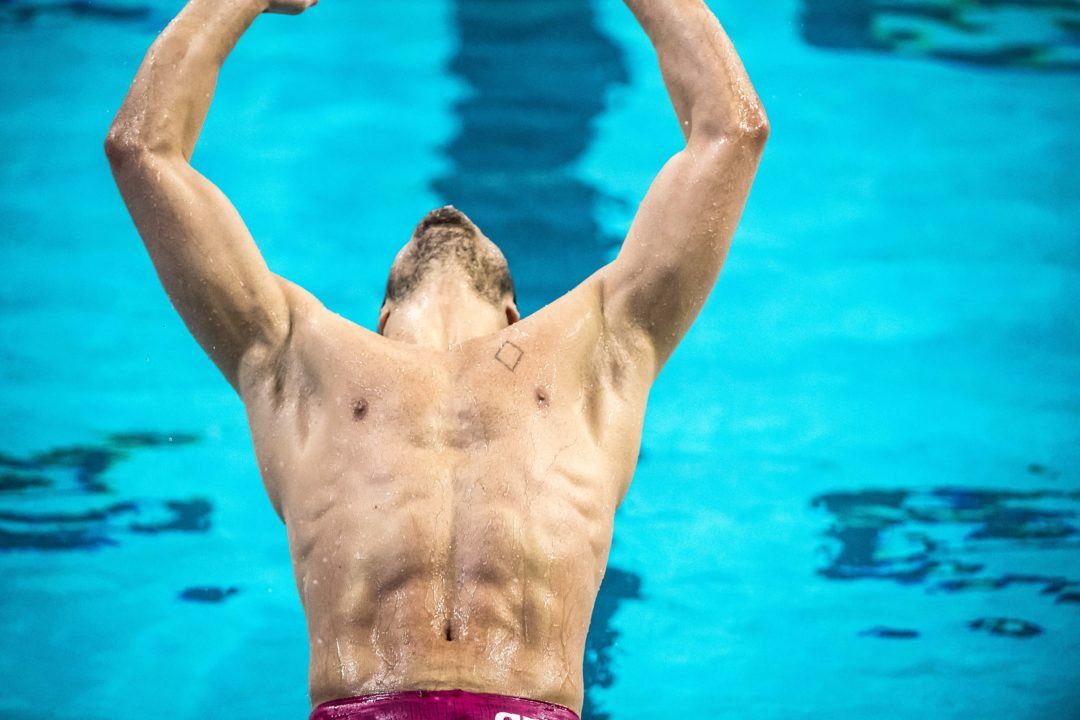Courtesy of RITTER Sports Performance, a SwimSwam partner
When it comes to swimming, we have a very skewed view of training. A few weeks ago, I attended the Pro Swim Series in Austin. As I walked around the Lee and Joe Jamail Texas Swimming Center, I couldn’t help but chuckle.
Swimmers and spectators alike watched Nathan Adrian and other elite level swimmers walk on deck with a commanding, strong presence. I heard countless remarks about how powerful and built these athletes looked. People commented on how they must strength train regularly and do more than just swim in the pool.
However, swimmers still loathe dryland and sometimes fail to realize the game-changing potential it brings to a swimmer’s career. This couldn’t be more true when discussing one movement, the pull-up.
I thought with the Michael Phelps Under Armor commercial, things might change.
I thought Cullen Jones and his historic run in 2008 would spark change. Cullen worked up to weighted pull-ups in the 80-90 lb range during that Olympic cycle.
I thought social media shedding light on the Olympic journey of athletes, like Simone Manuel, would provide the snapshot generations of swimmers would need to stop undervaluing dryland training.
Even recently, Siphiwe Baleka discussed his amazing journey to faster at 45 compared to his 21-year-old self. People were still surprised that strength and technique allowed him to significantly decrease his overall training volume and SWIM FASTER!
We still have work to do. It is time to stop fearing dryland. It is time to stop fearing the pull-up.
Are you ready?
As with learning a swimming stroke, the pull-up requires a focused progression. You can get to your first unassisted pull-up. You can achieve a new level of pull-up performance.
Where should you start?
Start with the necessary skills and assess where you fall short.
Pull-Up Skills Assessment:
-
- Can you hold a perfect plank for a minute?
- Can you complete a single-arm dumbbell row with 1/4 of your bodyweight?
- Can you actively hang on a pull-up bar for over a minute?
- Do yo have the proper shoulder mobility and stability to properly disperse force across the shoulder girdle?
The ability to complete an unassisted pull-up extends well past the movement itself. For example, think about if you a sprinter but can’t hold a solid plank for the duration of your event. What do you think is happening to your body positioning and efficiency as you approach the finish of a race? It’s probably not optimal!
The next thing you need to do is take a top-down approach.
Ready to start?
Unlock our top-down approach to pull-up mastery!
About RITTER Sports Performance:
RITTER Sports Performance helps swimmers go faster and coaches get better, worldwide. Through our online resources on strength training, stroke technique, swim-training, race analysis or nutritional coaching–RITTER is ready to help you take your swimming to the next level. Are you?
CONNECT WITH RITTER SPORTS PERFORMANCE:
WEBSITE
APPLE PODCAST
GOOGLE PLAY
SPOTIFY
SOUNDCLOUD
Swim training is courtesy of RITTER Sports Performance, a SwimSwam partner.



How many reps with 90lbs? I’m pretty sure Nathan or Peaty can do a single rep with north of 120lbs.
He was in the 5 rep range with 90lbs. No doubt Nathan and Peaty can pull an house!
There are 3 reasons why I prefer swimming over dryland training:
1) specificity
2) specificity
3) specificity
During an IM practice, swimmers will go through every competitive swimming motion possible.
I’m suspicious that any perceived improvement in the pool from a dryland training day is due to it acting as a mini taper because of dryland training’s poor specificity.
You’ll probably be called a USRPT nut for that statement, but as an exercise physiologist I 100% agree.
Yes, to be a better swimmer you need to swim, definitely not arguing that. However, I would argue that only swimming would actually put an athlete at risk for injury. Yes, swimming is specific but if a swimmer can’t hold proper body positioning and injury risks are rising, supplemental work is needed. Also, balancing the repetitive nature of swimming is critical. I honestly think the present and future of swimming is a high level of technique and strength. We are already seeing this on the masters side of things and this is rapidly expanding to other levels. Of course you have to swim to be a good swimmer, but I think neglecting other tools to help the process would be… Read more »
I am hoping this is supposed to be for swimmers past the onset of puberty, at the tail end and later of it. Especially with the research done in separation of scapula in especially teenage female swimmers and planks. That is a non-recoverable injury, if/when it happens.
What are SL pull-up and dropdown pull-up?
SL=straight leg and dropdown is focusing on the lowering phase of the movement. All the resources and demos are included in the link.